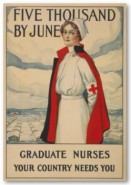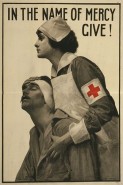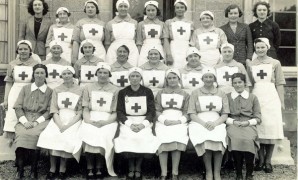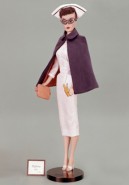World War I changed the way that wars were fought — technology had advanced to the point where long range weapons were possible. Unfortunately, medical technology did not advance at the same speed, meaning a great many more injuries, infections, casualties, and the need for more trained nurses. As a result, a nationwide recruiting effort began.
Since many of America’s nurses were serving in World War I, student nurses were left caring for thousands of flu-ridden people. Many of these young women died while tending to the sick.
At this time, an American surgeon named William Halsted was falling in love with head OR nurse and wife-to-be Caroline Hampton, who developed dermatitis from the harsh chemicals used to disinfect hands for surgery. Because of her discomfort, Halsted developed the first pair of latex gloves. He later went on to create surgical gowns and hats, too.
Many nurses began using gauze masks and gloves, and the spread of infection decreased.
Pictured below is the 1919 graduating class of the Massachusetts General Hospital that fought the Influenza Pandemic.
Here, an article (via Deedy.com) details the work of the student nurses:
Eighty Nurses Graduated in Victory Class at Mass. General Hospital
Eighty young women, constituting the “Victory” class of the Massachusetts General Hospital, after completing the hardest year of continuous hard nursing that has ever been done by pupil nurses in the history of the institution, were graduated last night.
Dr. Henry P. Walcott, chairman of the board of trustees, who presided at the exercises and announced the graduates, declared that each individual member of the class had done as high a service and incurred as grave a danger as any nurse or soldier in service abroad.
800 CASES OF FLUIE
The members of the class have in the past year nursed over 800 cases of influenza which came in two great waves. Over half of the class were seriously ill with the disease; and all, because of the severe tax which overwork placed upon them, were made dangerously susceptible. One of their number died. A scarlet fever epidemic placed 36 of the girls on the dangerous list, but all survived.
“There are no words,” said Dr. Henry Van Dyke, who made the address of the evening, “that can fittingly commend the part that women, and especially nurses, have played in the winning of the war. The type of service that did not flinch even before an enemy that chose as its favorite target that Red Cross on the roof of a hospital, can never be given its just reward in rhetoric.”
More than 59,000 American nurses served in the Army Nurse Corps during World War II. Nurses worked closer to the front lines than they ever had before. They served under fire in field and evacuation hospitals, on trains and ships, and as flight nurses on medical transport planes. The skill and dedication of these nurses contributed to the extremely low post-injury mortality rate among American military forces in every facet of the war. Overall, less than four percent of the American soldiers who received medical care in the field or underwent evacuation died from wounds or disease — a huge improvement from the previous world war.
Another improvement? Less bulky attire!
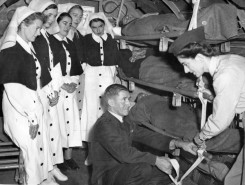
Australian Air Force nurses receiving Aeromedical Evacuation training during WWII (via defence.gov.au)

Starting in 1950 and moving through the 1960s, the intensive care unit was developed, leading to nursing specializations — meaning more autonomy for nurses.
The big development in the ’60s was the nurse practitioner movement. Nurses were becoming more independent and more educated, which was a sharp contrast to how they were portrayed in the media.
As you can see to the right, nurses were viewed as little more than the “help” (almost like back in the early 1900s, when they were little more than servants) looking to ensnare a rich doctor to take care of them.
Nurses were highly sexualized by the media — even Barbie had a nurse’s outfit! Her peeptoe heels and cat-eye glasses did nothing to further the respectability of the profession.
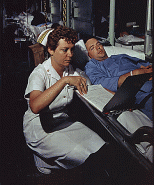 Around the ‘70s and ’80s, a major cultural shift in nursing took place — today’s scrubs with pants started to replace the impractical dresses. Now, nurses, aides and doctors are only differentiated by accessories and name tags.
Around the ‘70s and ’80s, a major cultural shift in nursing took place — today’s scrubs with pants started to replace the impractical dresses. Now, nurses, aides and doctors are only differentiated by accessories and name tags.
We’ve come a long way from “fever-shields” and now know that scrubs and proper hygiene prevent the spread of infectious diseases.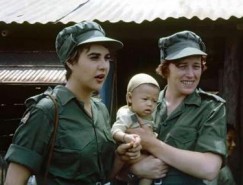
Take the Scrubs laundry poll!
We have a hunch…and want to prove it. All the nurses we know are saddled with what appears to be tons more laundry than civilians (especially if you’re in all white!). Is this the case with you?
The average household does around 8 loads of laundry each week.* Do you think nurses do more? Share your comments below!
*Source: Journal of Consumer Studies & Home Economics, July 2007
Related Reads:
9 Reasons to Fall in Love with Nursing
7 Things to Learn From a Lifer Nurse
Inspirational Quotes Every Nurse Should Read

